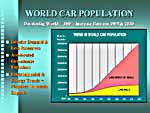|

World Car Population
Number of Cars in the Developing World
Will Increase 300% Between 1995 and 2020

Slide 2 of 13
Click image to enlarge.
For top quality images and fast viewing,
download the native PowerPoint file from the contents page.
|
Notes:
This slide shows the worldwide growth in automobile population. In North America
and Western Europe, the growth in automobile population is roughly equivalent to the
growth in human population. But in the developing world, growth is almost
exponential because of expanding economic growth. So business will be good, and none
of us will have to switch careers in order to make a living.
This accelerated growth in the world’s automobile population is accelerating the
pressure on finite oil reserves. Experts have been predicting a decline in oil
supplies for the last 50 years, and they just keep finding new fields and pushing the
envelope forward. But we all know the problem of basing the prospects for future
events on past events. If that worked, then healthy people could drop their
insurance, train-wrecks that haven’t happened yet, never would, and we would always
have plenty of petroleum reserves. There have been no major new oil field
discoveries since 1988, and today, the best estimations are that we can expect to see a
permanent global decline in oil production within 15 to 20 years - which doesn’t
stack up very well against the growth in demand.
Another pressure for change centers on greenhouse emissions, global warming, and
climatic change. From the last ice age until the industrial revolution in the last
century (~10,000 years), the atmospheric level of CO2 had varied only about 5%. But
beginning with the industrial revolution and projecting forward to 2030, the amount of
atmospheric CO2 will have doubled - all in about 150 years time. Global warming and
the resulting climatic changes are about as close to proven as something like this can be,
and the post-industrial increase in greenhouse gases looks like the culprit. One of
the biggest single contributors to the rise in greenhouse gases is the burning of fossil
fuels. With hydrocarbon fuels, C02 emissions are roughly proportional to the amount
of energy consumed, so a reduction in energy consumption naturally reduces CO2 emissions.
So when we look at the entire picture, there are compelling reasons for a switch to
more efficient transportation technologies. And one doesn’t have to subscribe
to the Malthusian meltdown theory in order to appreciate it. Ultimately, the
justification comes down to the task of insuring economic stability over the long haul.
The economic ramifications of mounting environmental problems, changing weather
patterns, and future monopolies and instability in energy supplies could be enough to
threaten the very foundations of our industrialized societies. It’s in
our own interests - it’s just good business practice - to create a more energy
efficient and sustainable system. And I think it even makes sense in terms of profits.
|
|
|